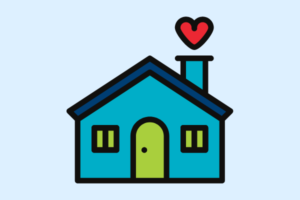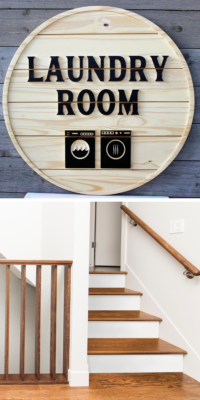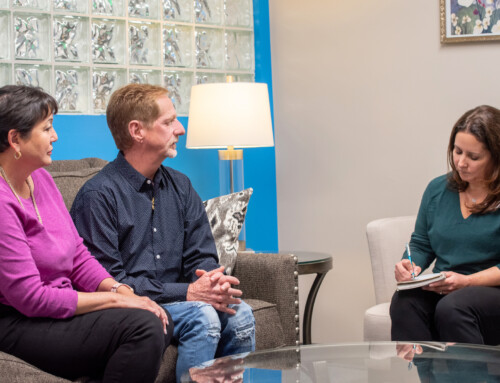Home – it’s a sanctuary for many of us, a place where we don’t have to think, we can just be. But for a person living with dementia, the idea of “home” can get a little complicated.
You are probably well aware of this if you’ve ever heard someone say they “want to go home” when, from what you can see, they are home, and in a house they have lived in for decades. What must it be like for a person when a place they knew like the back of their hand now feels foreign, where nothing is where it should be or works how it should work? And what can we do to help?
We can’t change what is happening in the brain that makes the home environment feel uncomfortable, but we can change the home environment itself.
When you think about home modification for a person living with dementia, you may picture installing grab bars or removing trip hazards. These kinds of changes can go a long way to make a person living with dementia feel secure and give their care partners peace of mind. But safety, while first priority, is not the end of the story.
Recently, there has been an increased focus on creating dementia-friendly spaces that promote not only security and comfort, but also confidence and independence. One concept that provides guidelines for these spaces is Universal Design (UD).
UD is an intentional process of planning housing and the physical environment to make daily life as easy as possible for as many people as possible. The goal is that any person, regardless who they are or how their brain or body functions, could enter and move around a building comfortably without needing special accommodations. Rooted in UD is the idea that we all experience changes in physical, mental, or cognitive functioning, whether due to disability, aging, illness, injury, or even just being tired or distracted, and our environments should be responsive to our changing needs without stigmatizing any condition or circumstance.
The concept of UD is largely used in architecture, and it directs how buildings should be laid out, constructed, and decorated. Universally designed buildings are:
- Equitable – they are welcoming to all people, regardless of their age, gender, size, mobility, etc. and they do not create barriers that exclude any group.
- Inclusive – everyone can use them with dignity; assistive features are integrated into the design (for example, grab bars should be sturdy and comfortable to grip, but they should also be an intentional part of the décor to avoid making those needing to use them feel singled out).
- Flexible – different people can use design elements in different ways, the same person can continue to use them as their needs change over time, or multiple options are provided.
- Intuitive – design elements are easy to understand for everyone regardless of the person’s experience, knowledge, language skills, or cognitive abilities.
- Easy – design elements can be used comfortably with minimal effort or fatigue.
- Safe – hazards are minimized, and mistakes or unintended actions are unlikely to harm the person or the building.
Click here to learn more about these UD principles >>
Ideally, homes and other spaces are built from scratch with these ideas in mind to promote the well-being of all future residents. But you can still use UD principles to make the home more comfortable for someone living with dementia, without expensive renovations.
Many solutions are low cost, like a bucket of paint, and some are even free – such as strategic rearranging of furniture. While it’s important to consider whether making changes to the home would be upsetting to a person living with dementia, creating an easily understandable environment as early and with as much input from the person as possible can be beneficial in the long run. Examples of modifications could include:
- Improving visibility throughout the home to provide cues and make tasks easier and more intuitive e.g. placing the outdoor garbage can in direct sight of the back door or putting a person’s favorite chair where they have a clear view and path to the bathroom.
- Ensuring all items are stored where the average person would expect them to be (e.g. sheets in the linen closet, dry goods in the pantry).
- Making signs, labels, and symbols part of your regular home décor to easily find and recognize the purpose of a room, closet, or cabinet.
- Painting the rising side of each step of the stairs a different color from the flat side to increase visibility and cue the need to step up.
- Distinguishing the home from other houses on the block by using features that act as landmarks, such as plants with a familiar scent near the entrance or a vibrantly colored door.
- Investing in glazed/glass-front cabinetry that allows a person to quickly identify what is inside.
- Installing double doors to offer more space as needed when entering the home, like when a person is using a walker or carrying large items.
To help determine what modifications could be made in your own home, try this exercise. As you go about your day, pretend you are a guest in a house you have never been in before and must make your way around without guidance from the host.
How would you determine which room is which? Would a sign or symbol be helpful on the door? Also, consider things that make a room instantly recognizable, such as a bed and a nightstand in the bedroom. Make note of anything that would not typically be placed in a certain room.
RELATED | Many people living with dementia will wander. Take Me Home can keep them safe >>
Think about trying to locate needed items and accomplish daily tasks. For example, would you be able to easily find soap, shampoo, and a towel to take a shower? Is the shower knob easy to understand and turn on and off?
Check outside as well. If you went for a walk, is there anything unique about the house’s exterior that would let you know you had returned to the right place? If looking at the fence for the first time, would you quickly notice where the gate and its latch are?
Finally, pay attention to any annoyances or inconveniences, however minor, such as stuck drawers or other faulty fixtures, street noises, or glaring lights. If they are frustrating to you, they will likely be much worse for a person experiencing cognitive impairment.
Viewing your home with a blank slate can be a good way to step into the shoes of a person living with dementia, for whom familiar places and items can easily become unfamiliar. Applying UD to create a dementia-friendly home means that the house and its pathways are easy to identify and maneuver, the purpose of rooms and objects is made clear, and features can be used with little difficulty or confusion.
UD-based modifications allow a person living with dementia to maximize their cognitive ability for as long as possible, and they reduce the barriers to daily living that often come with progression of the disease. They can also temper out-of-character behavior that stems from a person feeling frustrated, disoriented, or uncomfortable with what is around them. Ultimately, the person can move through life with less limitations, and in turn less shame and doubt, increasing their sense of self-efficacy, independence, and worth.
RESOURCE | Universal Design Guidelines for Dementia-Friendly Dwellings
The true benefit of Universal Design, however, is that these changes help improve the lives of not only people living with dementia, but of everyone in the home. How many times have you struggled to open a tricky door while carrying a heavy load of groceries or fumbled to find a light switch in a dark room? It’s likely that we all at some point have had to try a few doors until we found the bathroom in someone else’s home. Regardless of our circumstances, UD helps anticipate and alleviate potential problems in the environment so that they become one less difficulty in our lives, allowing us to focus on things that really matter to us. UD homes can be our sanctuaries in sickness and in health, no matter who we are and how we might change.
We are all different – in the way we think, the way we function, and the way we interact with the world. UD is not one-size-fits-all, but rather celebrates difference and allows everyone to feel included and navigate life without excess burden. If we take a moment to consider our environment from a place of empathy, we can create spaces where all have the opportunity not just to live, but to thrive.
For more information on Universal Design and ideas for home modification, check out this Digital Resources list.
Need support? Alzheimer’s San Diego is here to help! Give us a call at 858.492.4400 for expert guidance on how to live well with dementia, caregiving challenges, and more.







